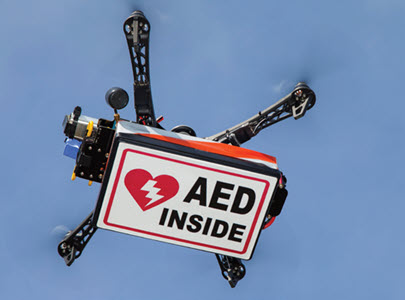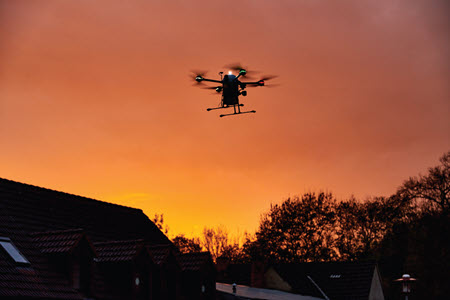Tech & Innovation in Healthcare
Deliver Emergency Services to Remote Areas With Drones
Patients can receive life-saving treatment in minutes.
On Jan. 2, 2023, the world watched as Damar Hamlin experienced an out-of-hospital cardiac arrest (OHCA) on the football field on national television. Medical personnel leapt into action performing cardiopulmonary resuscitation (CPR) and using an automated external defibrillator (AED) to revive the patient.
But, what about the average person living in a rural area who experiences cardiac arrest without an AED steps away? Researchers are studying the efficiency of using drones to deliver AEDs to remote locations faster than it would take emergency services to arrive.

Recognize Rural Emergency Care Hurdles
Between traffic, weather, and personnel shortages, emergency services face several challenges in delivering treatment in time. Delivering timely treatment is even harder in rural and remote locations. The Rural Health Information Hub reports that rural areas have only 13.1 physicians per 10,000 people, whereas urban areas experience 31.2 physicians per 10,000 people.
When a person living in a rural area experiences an OHCA, administering defibrillation becomes tougher. One way emergency personnel could deliver an AED quickly is by drone. “This could be beneficial in suburban and rural environments as AEDs are not located inside of homes and farms,” says Anthony Klappa, MD, FACC, RPVI, interventional cardiologist, Northwest Health, Springdale, Arkansas.
One barrier to wide-ranging adoption by regular citizens is the trepidation bystanders may feel in emergency situations. “How will the general population know if a drone will be dropping a care package ahead of the first responders’ appearance? This is an important consideration for this technology to move forward as an option for improving access to AEDs,” Dr. Klappa adds.
Put Patients in Range With Multiple Drone Stations
In a 2019 study, researchers explored the effectiveness of drone-assisted emergency responses to OHCAs in North Carolina. The researchers estimated that 16,503 adults would experience an OHCA with resuscitation among the 9.5 million North Carolina residents over four years, which is the average lifespan of a drone. While a small percentage of adults were estimated to experience an OHCA, only 26.2 percent of OHCAs would occur within five minutes of an emergency response station.
The researchers estimated 3,138 fire, ambulance, and police stations, and post offices could serve as potential drone docking stations. Using a five-minute flight range from the docking station to AED delivery, implementing 50 docking stations throughout the state would put 50 percent of the OHCAs within that five-minute range. The coverage grows to 89.7 percent of OHCAs if 750 docking stations are commissioned, and nearly 94 percent of OHCAs are in range with 1,015 docking stations in use.
At the same time, the increased number of drones significantly reduces the average minutes from dispatch to first AED delivery:
- No drones: 7 minutes
- 50 drones: 5 minutes
- 750 drones: 2.4 minutes
- 1,015 drones: 2.1 minutes
Receive an AED on the Doorstep
Several companies are using drones to deliver medical supplies to remote locations. One company, Everdrone, is using drones, called Emergency Medical Aerial Delivery (EMADE) service, to deliver AEDs to patients’ homes where emergency personnel or a bystander can administer the device.
“Everdrone is the only company in the world with a live operational system for emergency medical delivery by drone designed and regulatory approved for urban areas. This has been achieved through a close collaboration with Sweden’s national emergency dispatch centre, SOS Alarm, the Center for Resuscitation science at Karolinska Institutet, and Region Västra Götaland,” says Mats Sällström, CEO at Everdrone, Gothenburg, Sweden.
The reason to develop AED drone deliveries stemmed from problems associated with publicly available AEDs. These problems include:
- Location: Public AEDs may be positioned far away from where a patient is experiencing an OHCA. Without the AED located near the patient, emergency personnel can’t “justify the gap in CPR (hands-off period) that comes with instructing a single bystander to fetch an AED,” Sällström adds.
- Reliability: AEDs that are in public locations can be subject to damage or theft, have old batteries or pads, or aren’t available around the clock.
With a drone-delivered AED, the personnel receive the device where it’s needed immediately, and the AED is outfitted with fresh pads and batteries. Plus, the recipient can remain on the phone call while the emergency dispatcher carefully guides them through administering the AED.
Real-world success: The EMADE service has shown promise in several studies, and on Dec. 9, 2021, the service was put to the test in the real world. On that date, a 71-year-old man with a history of myocardial infarction (MI), heart failure, and atrial fibrillation experienced a cardiac arrest while shoveling snow outside his home. The patient was discovered by his wife, and an emergency physician who happened to be passing by initiated chest-compression-only resuscitation.

The emergency dispatch center notified EMS, while a smartphone was used to dispatch an AED-equipped drone and volunteers with CPR training to the scene. “The drone flew autonomously out of sight for 673 m and, at 3 minutes 19 seconds after dispatch, safely delivered an AED in the snow 10 m from the patient before EMS had arrived,” researchers, Sofia Shierbeck, MD, Leif Svensson, MD, PhD, and Andreas Claesson, RN, PhD, wrote in a letter published in The New England Journal of Medicine on May 19, 2022.
Following retrieval of the AED, the emergency physician immediately attached the AED to the patient to defibrillate ventricular fibrillation. “The first shock was delivered by the emergency physician just before the arrival of ambulance personnel at the patient’s side,” the researchers wrote. EMS personnel arrived and administered a chest-compression device and advanced life support and transported the patient to a hospital. Following a seven-day inpatient stay, the patient was discharged and made a “full neurologic recovery.”
Next generation: Sällström says Everdrone’s next generation of drones will be launched later in 2023. In addition to having faster speed, a greater range, and the ability to handle more diverse weather conditions, the drones “will also be able to deliver other products than AEDs, such as anti-bleeding kits, Naloxone, and EpiPens,” Sällström adds.
Tech & Innovation in Healthcare
- Artificial Intelligence:
Use AI to Identify Complex Critical Care Cases
Sing the praises of a multicenter program. Artificial intelligence (AI) has shown promise in many [...] - Drones:
Deliver Emergency Services to Remote Areas With Drones
Patients can receive life-saving treatment in minutes. On Jan. 2, 2023, the world watched as [...] - Compliance:
Is a ‘Cures Act’ Rule Follow-Up in the Works? Find out
Learn about the feds’ proposed changes. Now that the COVID-19 public health emergency (PHE) is [...] - Industry Notes:
Settlement Payments Continue to Accrue for EyeMed Vision Care
On May 16, 2023, New Jersey Attorney General Matthew J. Platkin announced EyeMed Vision [...] - Reader Questions:
Don’t Let an Outdated OS Be Your Practice’s Breach Point
Question: Our IT and cybersecurity teams provide continued education to ensure our staff and clinicians stay [...] - Reader Questions:
Use Caution When Implementing AI, Urges WHO
Question: With the popularity of different artificial intelligence (AI) systems, are there any concerns about deploying [...] - Reader Questions:
Remember the Difference Between Remote Wiping and Disabling
Question: Healthcare providers in our practice often use their personal tablets, laptops, or smartphones for work [...] - Reader Questions:
Take Care of e-Signature Security
Question: A recent compliance risk assessment determined that the e-signatures we use and have our patients [...]

